Milk Hill of June 2009 seems to predict a new, bright astronomical object in our solar system, possibly a comet or even an “extra planet”, on the new Moon of June 1, 2011 Over slightly more than a week in June of 2009, a large new crop picture appeared at Milk Hill in southern England in three separate phases (see milkhill2009c or lucypringle.co.uk or lucypringle). Almost two years later now in April of 2011, still no one seems to understand what they were trying to tell us there! While we were studying several crop pictures which may predict an enigmatic “planet X” for December of 2012, we came across some distinctive astronomical symbols in Milk Hill of June 2009. Those distinctive symbols suggest that it may refer to an upcoming date in June of 2011. To be more precise, the Milk Hill crop picture of 2009 seems to show a rare planetary alignment which will only occur once in the near future on June 1, 2011. It also shows an extra anomalous symbol to represent a “new astronomical object” in our solar system, currently of unknown origin, which will supposedly be seen on the same date. The new object could be a “comet in outburst”, as we saw predicted in crops between 2005 and 2007 for Comet 17P Holmes (see time2007g or time2007h). Alternatively, it could be our first glimpse of the enigmatic “planet X”. Interestingly enough, those crop artists counted it in their Milk Hill field diagram as an “extra planet” between Mars and Jupiter. The unknown object is not Comet Elenin, nor is it Comet Holmes in a second outburst. The first part of Milk Hill on June 21, 2009 showed an “astronomical sextant” with five different planetary orbits attached, as may be seen when looking up into Earth’s sky Phase I of Milk Hill showed the symbolism of an “astronomical sextant” as explained below: Five different “planetary orbits” (drawn as curved thin lines) were attached to that “sextant”, meaning that we should look up into Earth’s sky on some upcoming date, to see five bright planets (or the Moon) lined up in a row. Each of those five orbits begins on “Earth” (red letters), where a “horizontal viewing tube” might be located on any sextant (see the white sextant at lower right). Yet which planets, and on which calendar date? The second part of Milk Hill on June 23, 2009 showed more of those five planetary orbits, looking up into Earth’s sky using a sextant Phase II of Milk Hill showed considerably more detail for those five planetary orbits, which are now numbered on the left (in yellow) as 1-2-3-4-6, or below (in blue) as 1-2-3-4-5: On the right we can also see six “altitude boxes”, which tell how high above the horizon each of six bright objects will be on some upcoming date. Planet “1” will be low in the sky, while planets “2” and “3” will be of medium height, and then planets “X”, “4’ and “5” will be high. Since planet Earth is clearly missing from those five curved orbits, we can tentatively assign planet “1” as the Moon, planet “2” as Mercury, planet “3” as Venus, planet “4” as Mars, and planet “5” as Jupiter. The crop diagram shows a small circled object between planets “3” and “4”, which we have labeled as planet “X”. That unknown object “X” seems to change the planetary numbering for Jupiter from “5” to “6”, when it is included on the left (in yellow), but not when it is omitted below (in blue). This would seem to imply that it lies somewhere in space between Mars and Jupiter, although we may be able to see it soon in projection from Earth, between the apparent sky locations of Venus and Mars. It seems less likely that planet “6” could be Saturn, while omitting planet “5” as Jupiter, although such an alternative interpretation cannot be completely ruled out. So do those distinctive astronomical symbols, drawn in an English crop picture, have any real-life solution in Earth’s sky? Such a rare alignment of five planets will appear on the new Moon of June 2, 2011 at sunrise in Sydney, or 10 hours later in southern England Yes, the astronomical symbols which were drawn in crops at Milk Hill during June of 2009 do have a real-life solution! Such a rare alignment of five bright objects will appear on the new Moon of June 1, 2011. Those four planets (and the Moon) will be clearly visible at sunrise on June 2 in Sydney, Australia, or 10 hours later in southern England (see iceinspace): On that day, the Moon and four bright planets will line up in Earth’s sky in a very distinctive fashion. A new Moon will be located close to the horizon at “low altitude”, while Mercury and Venus will follow just above at “medium altitude”, then Mars and Jupiter will follow at “high altitude”. The relative altitudes of those five planets as measured with a sextant seem correct for a new Moon of June 1, 2011 When we compare the real sky altitudes of those five planets (for sunrise in Sydney on June 2) with their approximate values as predicted in crops at Milk Hill, we can see a reasonably good match: Planet “X” has not been included in the sky diagram, which is based on known planetary objects within our solar system. Yet the crop picture from Milk Hill 2009 seems to tell us that we will see a bright unknown object between Venus and Mars when viewed from Earth, on the new Moon of June 1, 2011, if we have interpreted it correctly. The unknown object “X” was circled to indicate its importance, and may appear between 3 = Venus and 4 = Mars as seen from Earth When we look more closely at how planet “X” was portrayed in Milk Hill of 2009, we can see a small circled object with standing crop at its centre, somewhere between the apparent sky locations of Venus and Mars as viewed from Earth: Strangely enough, planet “5” or Jupiter becomes “6” on the left, once planet “X” is included, although its main count remains “5” below, where planet “X” has been omitted. We can even see where a curved line (orbit) for planet “6” on the left, joins directly to five small balls below which represent “planet “5”. That would be a strange way to describe some new comet, but we will have to wait and see. The third part of Milk Hill on June 30, 2009 showed a series of strange astronomical hieroglyphs that were clearly alien-made Perhaps to dispel any possible notion that Phases I and II could have been carved out by local human fakers, using rope and boards, Phase III of Milk Hill 2009 showed an amazing series of astronomical hieroglyphs, stretching across the green field for approximately 500 meters: No one currently has any idea what those alien-made symbols might mean. Summary and conclusions In the analysis presented above, we related many astronomical symbols from a crop picture which appeared at Milk Hill in June of 2009, to an upcoming sky alignment of four bright planets and the Moon on June 1, 2011. Then we suggested that an “anomalous extra symbol” from the same crop picture might represent a “new astronomical object” in Earth’s sky, to be seen on the same date. Several questions arise here. First, how rare is the upcoming planetary alignment on June 1, 2011? Can we be absolutely sure that we have deduced the correct date? No, we cannot be absolutely sure, but the field data when compared to the astronomical data appear quite suggestive. By April 30 of 2011, the Moon, Mercury, Venus, Mars and Jupiter will create an approximate linear shape in Earth’s sky (see nightsky). Then during the entire month of May, they will provide a remarkable display which Sky and Telescope calls the “Four Planet Dance of 2011”, culminating on a new Moon of June 1, 2011 (see skyandtelescope or skyandtelescope). The last close approach in Earth’s sky (or conjunction) between Mars and Jupiter was in February of 2009, just before Milk Hill in June (see mikesalway or iceinspace.com). Those four objects Moon, Mercury, Mars and Jupiter (without Venus) did not create a linear shape then as they will in 2011. The next close approach between Mars and Jupiter will be in July of 2013, again without Venus (see planets). Thus the upcoming planetary alignment on June 1, 2011 is quite rare, and will not be repeated anytime in the near future. Nor will planet Saturn enter into a linear conjunction with Venus and Mars anytime in the near future. There was a conjunction of Venus, Mars and Saturn in August of 2010, but not in a linear shape (see berthoudrecorder). The next Mars-Saturn conjunction will be in August of 2012, and will not include Venus. The last linear arrangement of Mercury, Venus, Mars and Saturn was in April of 2002 (see thunderbolts). Secondly, what might the small “circled” symbol in Milk Hill of 2009 refer to? Are they trying to tell us about a bright new comet, or something more important concerning an enigmatic “planet X”? We cannot say for sure, based on current information. A similar symbol was drawn at Bluebell Hill in August of 2005 to predict the outburst of Comet 17P Holmes in October of 2007 (see time2007h). So it might be just a comet, yet those crop artists seem to number it in their field diagram as an “extra planet”, whose orbit does not lie in the plane of the ecliptic as for five other known objects shown there. Really we have no other option now but to wait and see! Several crop pictures from the summer of 2009 could be interpreted in terms of a “new astronomical object”, but none except Milk Hill seem to give a clear fit to known planetary locations. If our proposed fit to the planets on June 1, 2011 is correct, then we should see something unusual in the morning sky on that day. Red Collie (Dr. Horace R. Drew, Ph.D. Caltech 1976-81, MRC LMB Cambridge 1982-86, CSIRO Australia 1987-2010) P.S. We would like to thank all of the people from Crop Circle Connector for use of their aerial or ground photographs for research purposes, especially Julian Gibsone, Stuart Dike, Annemieke Witteveen and Olivier Morel. Appendix 1. Altitudes and azimuths for five bright planetary objects on June 1, 2011 In order to accurately describe the crop picture shown at Milk Hill in 2009, we need to show two things. First, five bright planets (or the Moon) should line up sequentially in “altitude” as measured with a sextant. Secondly, those five bright planets (or the Moon) should also line up sequentially in “azimuth”, as measured with a compass along the horizon. We therefore calculated a series of altitudes or azimuths for the two dates of June 2, 2011 at sunrise in Sydney, or 10 hours later for sunrise in southern England, using a program called “Solar System Live” (see /solar). Those data are listed in Tables 1 and 2 below. Table 1. Five bright planets as seen from Sydney on the new Moon of June 1, 2011 at 21:03:42 UTC (latitude 34o S, longitude 151o E, local time 0700 on June 2) Milk Hill number Astronomical object Right Ascension Declination Altitude (34o S) Azimuth ---- Sun 4 h 38 min +22o +1o -118o 1 Moon 4 h 37 min +23o +1o -119o 2 Mercury 3 h 44 min +19o +13o -123o 3 Venus 3 h 14 min +16o +19o -127o --- unknown object 4 Mars 2 h 55 min +16o +23o -131o 5 (or 6) Jupiter 1 h 51 min +10o +37o -141o --- Saturn 12 h 43 min -2o -52o +23o Table 2. Five bright planets as seen from southern England just after the new Moon on June 2, 2011 at 04:00:00 UTC (latitude 52o N, longitude 1o W) 4 h 39 min Milk Hill number Astronomical object Right Ascension Declination Altitude (52o N) Azimuth ---- Sun +22o +1o -126o 1 Moon 4 h 53 min +23o +0o -129o 2 Mercury 3 h 46 min +19o +5o -114o 3 Venus 3 h 15 min +17o +8o -107o --- unknown object 4 Mars 2 h 56 min +16o +11o -103o 5 (or 6) Jupiter 1 h 51 min +10o +16o -86o --- Saturn 12 h 43 min -2o -19o +113o Both sets of altitudes do line up sequentially as required: from +1o to +37o in Sydney, or from +0o to +16o in southern England, when going from the Moon to Mercury to Venus to Mars to Jupiter. Likewise, both sets of azimuths do line up sequentially as required: from -119o to -141o in Sydney, or from -129o to -86o in southern England, for the same series of bright sky objects. Some of the data for southern England at sunrise on June 2, 2011 are shown below. They seem to be in excellent accord with the sky map, as well as with the Milk Hill crop picture: Relative directions of planetary motion, as shown by “thin curved lines” in the crop picture on the right, are also correct for hourly times later than sunrise. In other words, Jupiter and all of the planets drawn there will move “up and to the left” as the Sun rises, to more positive altitudes and less negative azimuths. We tried earlier to fit these data to a canonical date of December 23, 2012, but planet Mars (4) was far out of place, and sextant altitudes were not explained. The correct date seems therefore to be June 1, 2011, although this cannot be established with absolute certainty. Appendix 2. Another possible solution to Milk Hill 2009 for almost the same date of June 3, 2011 On further study, we have found another possible solution to Milk Hill 2009 for almost the same date of June 3, 2011. At sunrise on that day, all five planets Mercury, Venus, Mars, Jupiter and Uranus will line up sequentially in Earth’s sky, with the Sun and Moon trailing behind: We cannot find any other linear arrangement of five planets between June 2009 and December 2012 (or even 2015), although we would of course be open to alternatives? On that day, some mystery object (labelled with a yellow “X”) has been predicted to appear in Earth’s sky between the third and fourth planets going outward from the Sun, namely Mars and Jupiter: The crop artists number that mystery object as a “sixth planet”. Thus they count 1-2-3-4-5-6 planets in total for their field diagram, and likewise six “sextant altitude boxes”. We should see the mystery object in Earth’s sky just below Jupiter, but it may lie in space between the orbits of Jupiter and Uranus. It does not seem to lie in the ecliptic with the other five planets, but may cross the ecliptic on that date. Currently in early May of 2011, Jupiter lies close to the Sun along the eastern horizon, and so we would not be able to see any faint object below it. The mystery object may also outburst to greater brightness like a comet, as it approaches the Sun in late May or June, if this is indeed the planetary alignment to which those crop artists are referring. Appendix 3. A likely candidate for the mystery sky object shown in crops at Milk Hill in June of 2009, or in the Netherlands during April of 2011 As discussed above, several crop pictures seem to predict a “mystery sky object” during a rare linear alignment of five planets Mercury, Venus, Mars, Jupiter and Uranus in early June of 2011. It could be a dim comet in outburst, as was seen for Comet 17P Holmes in crops during 2005 (see /time2007g or time2007h), or it could be something far more exotic as an “extra planet”. Upon a careful study of astronomy websites (see remanzacco.blogspot.com), we have found that one particular comet, namely C/2011 C1 McNaught, will be in almost the precise sky location during early June of 2011 to explain most of the crop-based predictions (see nasa.gov): In other words, all Comet C/2011 C1 has to do (in order to explain these predictions) is to get much brighter, which is something that comets often do after passing the Sun! It reached solar perihelion on April 18, 2011, and will cross the ecliptic on June 19, 2011. Early in June it will appear slightly above Jupiter as seen from Earth (as shown in the Netherlands), while later in June it will appear slightly below Jupiter as seen from Earth (as shown at Milk Hill, while crossing the ecliptic). The significance of this astronomical event, if it comes true, would be to establish once and for all the paranormal, future-predictive nature of certain crop pictures. Thus, Comet C/2011 C1 was not discovered until February 10, 2011, while a “mystery sky object” was shown in crops on June 23, 2009 at Milk Hill in England, and again on April 24, 2011 in the Netherlands (see Bosschenhoofd2011). This addendum is being posted on May 3, 2011, before any cometary outburst has been detected. 

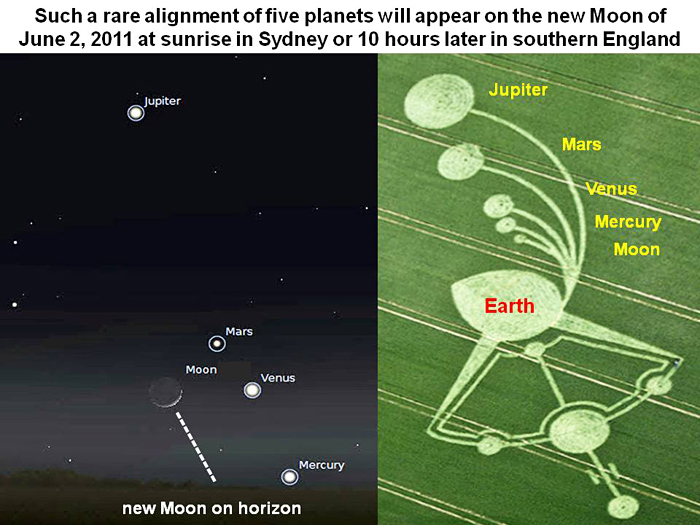
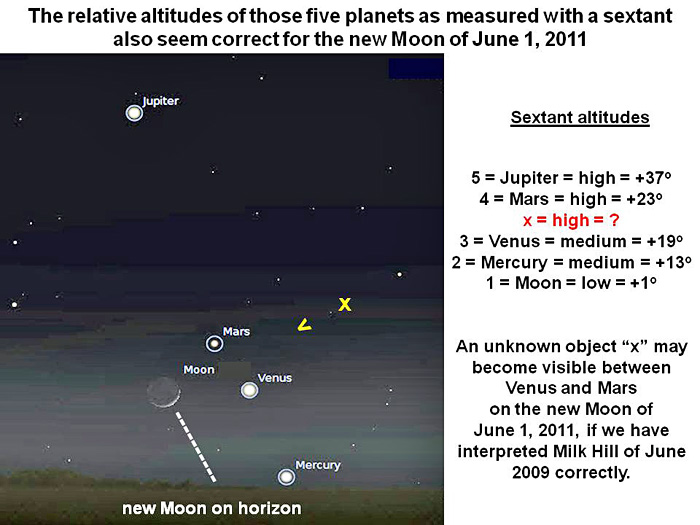
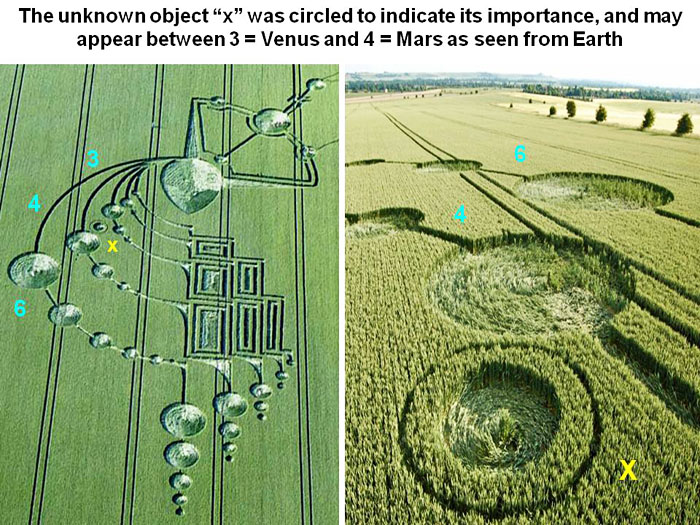
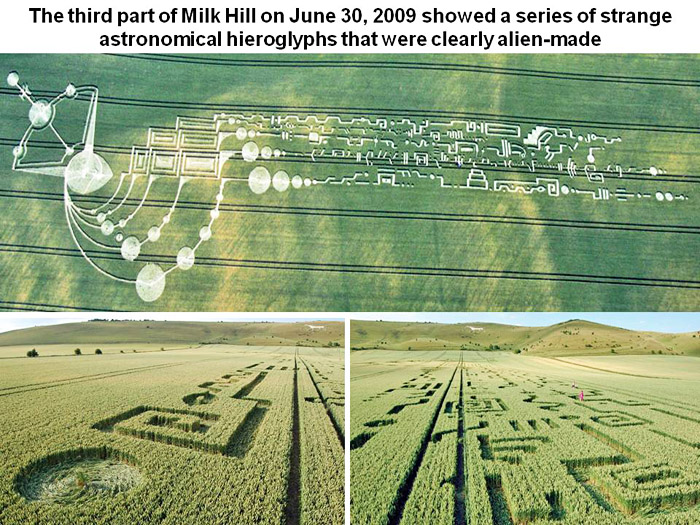

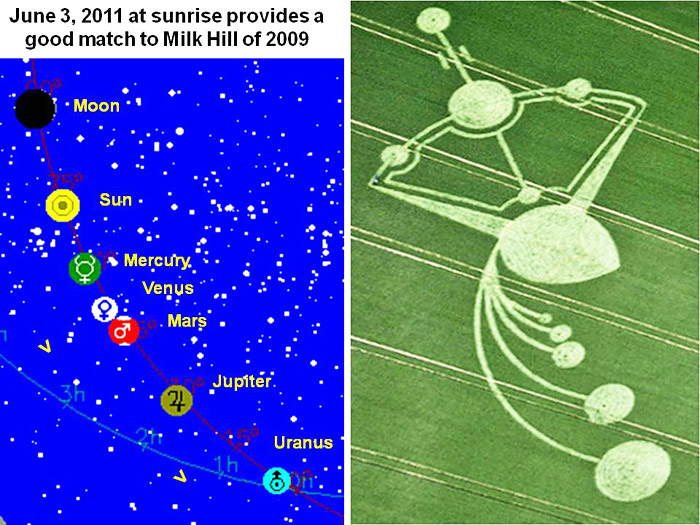
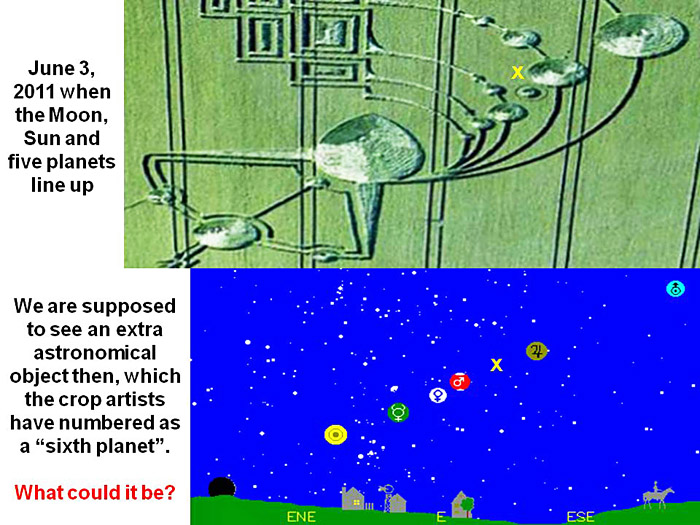
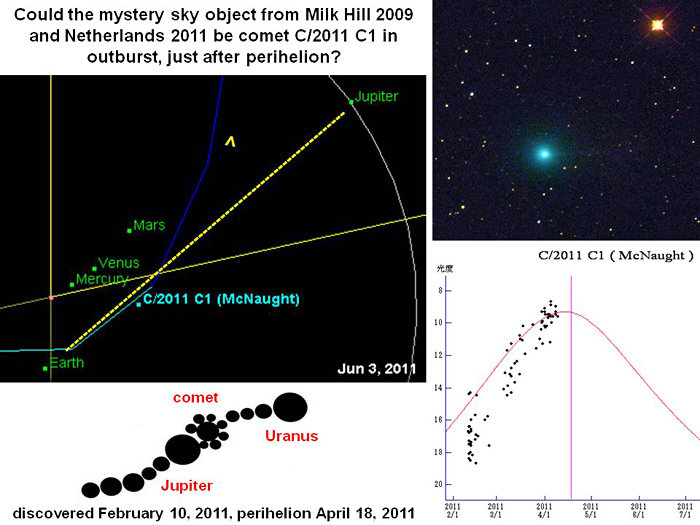
Unknown Astronomical Object Arriving June 2011?
none;border-left: none;border-bottom:solid windowtext 1.0pt;border-right:solid windowtext 1.0pt; padding:0cm 5.4pt 0cm 5.4pt" valign="top" width="120">







No comments